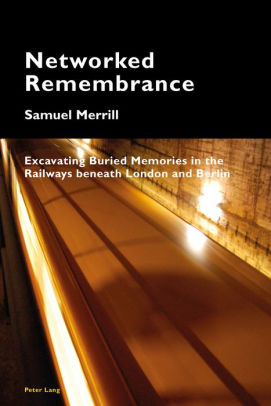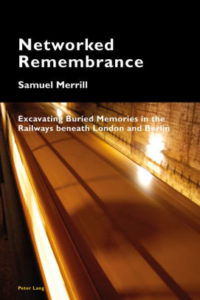
Networked Remembrance: Excavating Buried Memories in the Railways beneath London and Berlin by Samuel Merrill

The widespread fascination with the landscape of underground railways is not difficult to understand. This is a realm frequently visited by large numbers of people who realize that they only glimpse fragments of a much larger system. The fact that these structures lie under the earth, and often lack illumination, ensures that many of us will wonder what might be hidden there, concealed by a cloak of darkness. Anyone who has looked for information on urban rail networks knows that there is an enormous non-scholarly literature produced by self-styled “railfans” who revel in the historical and contemporary details of rolling stock, stations, names, and much else. Samuel Merrill’s Networked Remembrance presumably feeds on some of that enthusiasm, and it contributes original research on obscure sites. However, the author does not write as a railfan. The book began as a dissertation in urban geography, and it is framed, at some length, in that discipline’s theories and terminology.
One obvious way that Merrill’s book differs from the effusions of most railfans is its inclusion of two cities. The comparative approach distances his work from local enthusiasms and also shifts its focus away from the peculiar physical and governing structures of a single network. Merrill’s larger purpose is, instead, to develop theories of place and memory, rather than concentrate on local transit policy or on historical questions unique to each city, notably the extent to which sites in Berlin, including those he studies, have been caught up in broader debates about national identity in urban space. Why include these two cities in particular? There is no compelling reason, although their rail networks are certainly among the world’s most storied—London‘s because of its size and long history, Berlin‘s above all because of the disruptions of war and division.
After theoretical and historical introductions, the book’s core chapters alternate between the two cities, examining the history of London’s iconic Tube maps; the naming and renaming of Berlin stations; initiatives to commemorate Silvio Meier, a young East German activist murdered by neo-Nazis in a subway station in 1992; the creation of memorials to catastrophic London Underground accidents; efforts to rediscover abandoned London Tube stations; and artistic adaptations of the never-completed and nearly forgotten U10 line under Berlin. Each of these case studies is paired with a briefer treatment of a comparable issue or controversy in the other city: Berlin’s network map; London station names; commemorations of Jean Charles De Menezes, an innocent man shot by police in a Tube station; the absence of memorials to Berlin underground accidents; the rediscovery of the “ghost” stations that were closed while the Berlin Wall stood; and a high-profile art project in the abandoned Aldwych station. Many readers will have heard about some of these stories, such as the much-discussed history of London Underground maps or the many disputes that accompanied the division and reunification of Berlin’s rail network. Few will be familiar with all of them. For anyone interested in urban rail history, there is a great deal of interesting material here, the fruit of extensive research, including interviews as well as published and archival documents (unfortunately marred by the frequent misspelling of German names).
This is a deliberately diverse selection of memory sites. They tell us a good deal about how the rail systems are woven into people’s lives beyond their function as mere transportation. Some of Merrill’s examples clearly are essential chapters in the rail systems’ histories: fires and accidents, in the most painful ways; maps and station names that matter to a minority and at least float across the consciousness of every user. Others, notably the deaths of Meier and De Menzies, occurred in the Underground but can been seen as incidental to it.
As much as Merrill contributes to the history of the rail networks, that is not his declared purpose. Most of his text is devoted to the individuals and institutions that contributed to (or opposed) the maps, names, memorials, and explorations he describes. The public or quasi-private transport authorities are major players in all these stories. So are the “enthusiasts,” as Merrill calls them, including artists eyeing underground spaces, politically engaged activists seeking to guard public memory of important events, and intrepid amateur (and often lawbreaking) explorers of the underground. However, these characters’ backgrounds and motivations interest Merrill only insofar as they help him develop his analysis of broader and more abstract processes of collective memory. The book is framed not as a history but as an analysis of memory “discourses,” along with “processes” and “structures,” (333) as revealed by the exchanges among these “mnemonic actors.” And this is where the going can get tough for the reader.
No discussion of underground sites can avoid the resonant language we use to explain, and usually conflate, literal and figurative darkness, depths, excavations, and burials. But Merrill spurns a literary approach. His intent is to build on a body of geographical theory that attempts to transform the everyday if metaphorical language of rail users and “mnemonic actors” into a rational and systematic method for explaining their fascination and engagement with rail sites. Geographers’ theoretical transformations of everyday metaphors can be opaque to outsiders. Indeed, some of us outside the discipline may wonder whether it is fruitful or illuminating to build a system out of literary language. Take Merrill’s title, which is at the very least a clever allusion to the ways both railways and neural memories form dense and unexpected connections. His use of the phrase, however, conceals broader ambitions. This is how he begins to explain his method: “The stories, tales and accounts that this book provides, along with the broader mnemonic geographies within which they lie, are conceived rhizomatically in a horizontal manner through the notion of networked remembrance, and stratigraphically in a vertical manner through the notion of buried memories. These overlapping and interrelated concepts are combined to create a volumetric understanding of urban memory.” (21)
Merrill’s introduction and substantial first chapter sift through a great deal of theoretical scholarly literature on place and memory in order to frame his own approach to his material. He recognizes that familiar terms used to explain our interest in the urban underground can conceal as much as they reveal. What, for example, are “cultural landscapes”? Among other things, “framing underground railways as landscapes … ontologically foregrounds their connective and vertical character.” (10) This material is intended to anchor the “mnemonic actors” of these railways in broader currents of geographical theorizing. The audience of that material, however, may be different from that for his more readable chapters on history and activism.
Reviewed by Brian Ladd, University of Albany
Networked Remembrance: Excavating Buried Memories in the Railways beneath London and Berlin
by Samuel Merrill
Publisher: Peter Lang
Paperback / 404 pages / 2017
ISBN 978-3-0343-1919-5
To read more book reviews click here.
Published on October 2, 2018.
Click here for our special feature on Contemporary Urban Research in the European City.




